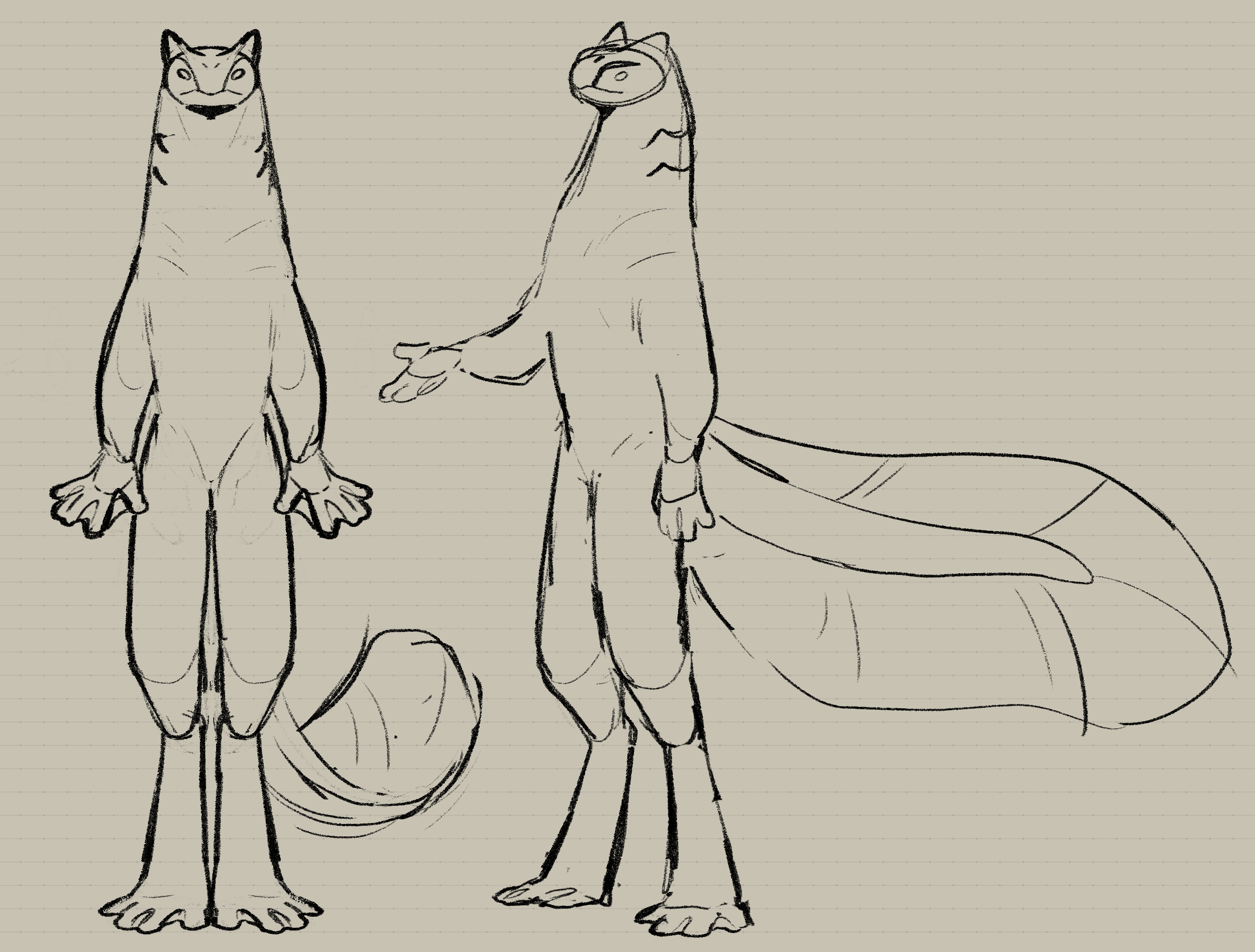
Hanasei are a semiaquatic species that originated from lakes, but expanded their settlements into rivers and other large bodies of water. They're a medium-sized biped characterized by their hard keratin “helmets” that sprout horns, as well as a tail with large fins. Their skin is slightly damp and can range in texture from smooth to bumpy, which affects their transpiration and how often they must hydrate. Located on their helmet is a pair of nostrils that are used for terrestrial respiration. The gills, ranging from 2 to 4 located on both sides of their neck, are used for speech while on land and for breathing when underwater. Their necks are strong and well-developed, able to expand or contract as needed.
Both hands and feet have webbed digits to facilitate swimming, but the webbing on the hands can retract for better dexterity when handling utensils. Their amphibious lifestyle has left them only decent at both land and water locomotion, but their versatility makes up for it as they can comfortably transition to both environments. They're hyper-carnivores and will eat anything made of animal matter, including bones.
They are the only sexless sophont in Koegama, using Aether as a reproduction tool instead of a biological system.
Physiology Notes
Head
The common head structure of a Hanasei is somewhat flat, with a stout snout and large jaws. Proportions and shape vary per individual, with slight deviations from standard models being common.
Occasionally, small whisker-like structures called “barbels” will grow from their jaw and upper lip area. These barbels give a slight boon to the olfactory systems, but otherwise have no major benefits.
Horns

A Hanasei with broken and fractured horns from old age.
While the protrusions on Hanasei's heads are not technically horns, but a different keratinous appendage, horns are the most commonly used colloquial term. Their main purpose were for fighting and as a display of health and fitness to potential partners. Nowadays, most Hanasei have no real use for their horns other than ornamentation, though individuals may favor different horn styles over others as a matter of personal preference.
They don't shed, growing steadily from infancy until plateauing in development at around 23 to 27 years old. If a horn is broken mid-development, it will continue to grow, resulting in mismatched horns and branched protrusions depending on the type of damage sustained. Once the horns stop growing, the blood and nervous systems that facilitated their growth will shrink and retract to be absorbed, leaving the area with no sensation and regrowth impossible. Cracks and missing pieces are a common sign of age.
Variance
Horns are very vulnerable to Aether tampering, leading to numerous styles and types emerging. Larger, more elaborate horns can make swimming more difficult, but overall the range in appearances is stable and harmless.
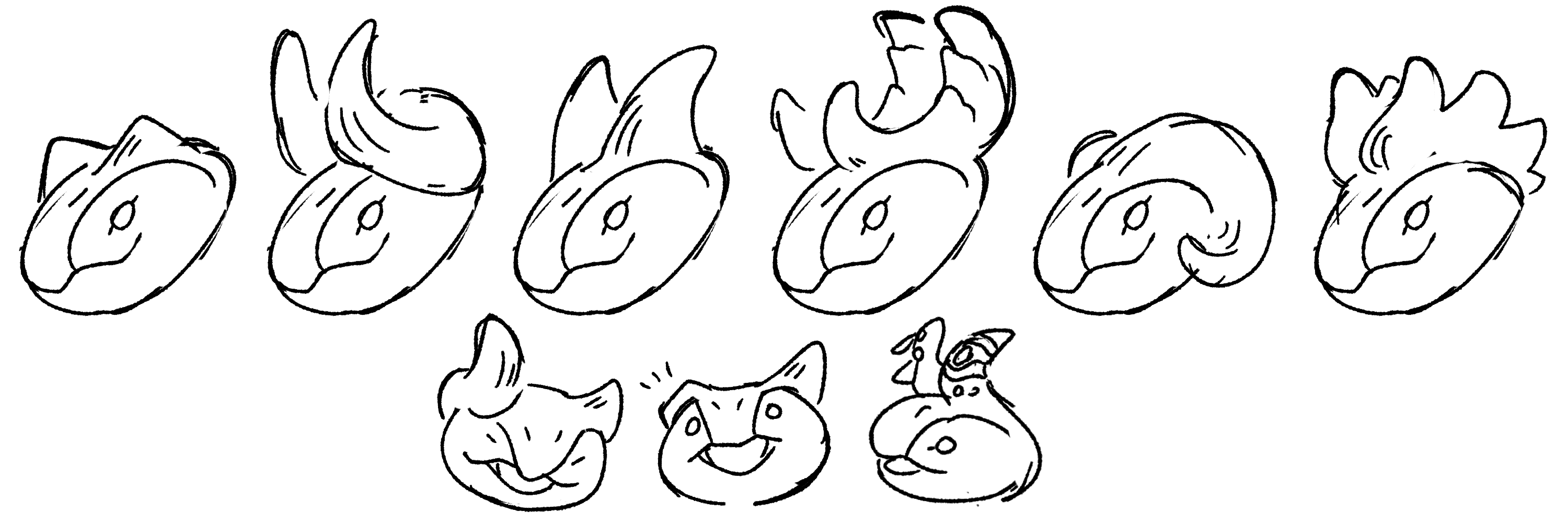
Top: An example of observable horn styles in Hanasei. Extra horn branchs and curling are common characteristics in many individuals.
Bottom: Asymmetry in horns can manifest as mismatched horn types, growth deficiencies and manual styling: carvings, accessories, etc.
The presence of horns and the pair number is not affected, with a minimum of 2 horns always present.
Eyes & Ears
Hanasei have good night vision, but poor eyesight in general. They can recognize the shapes around them and a few colors, but their daylight and night vision are almost the same otherwise. Their eyes can have different shapes and colors, but the effect is purely visual as their eye sensors work the same regardless of their appearance.

Left: A collection of some eye shapes and patterns found in Hanasei, and how their nictating membrane appears.
Right: Hanasei eyes are reflective, and shine when light is pointed at them, especially in low light.
Hanasei don't have visible ears, but a tympanic membrane around their cheek area which is able to pick up vibrations both in and out of water. They have great hearing and are more aware of vibrations such as tremors and footsteps. They can voluntarily close their inner ear to stop themselves from picking up sounds, a common method to aid in falling asleep.
Mouth
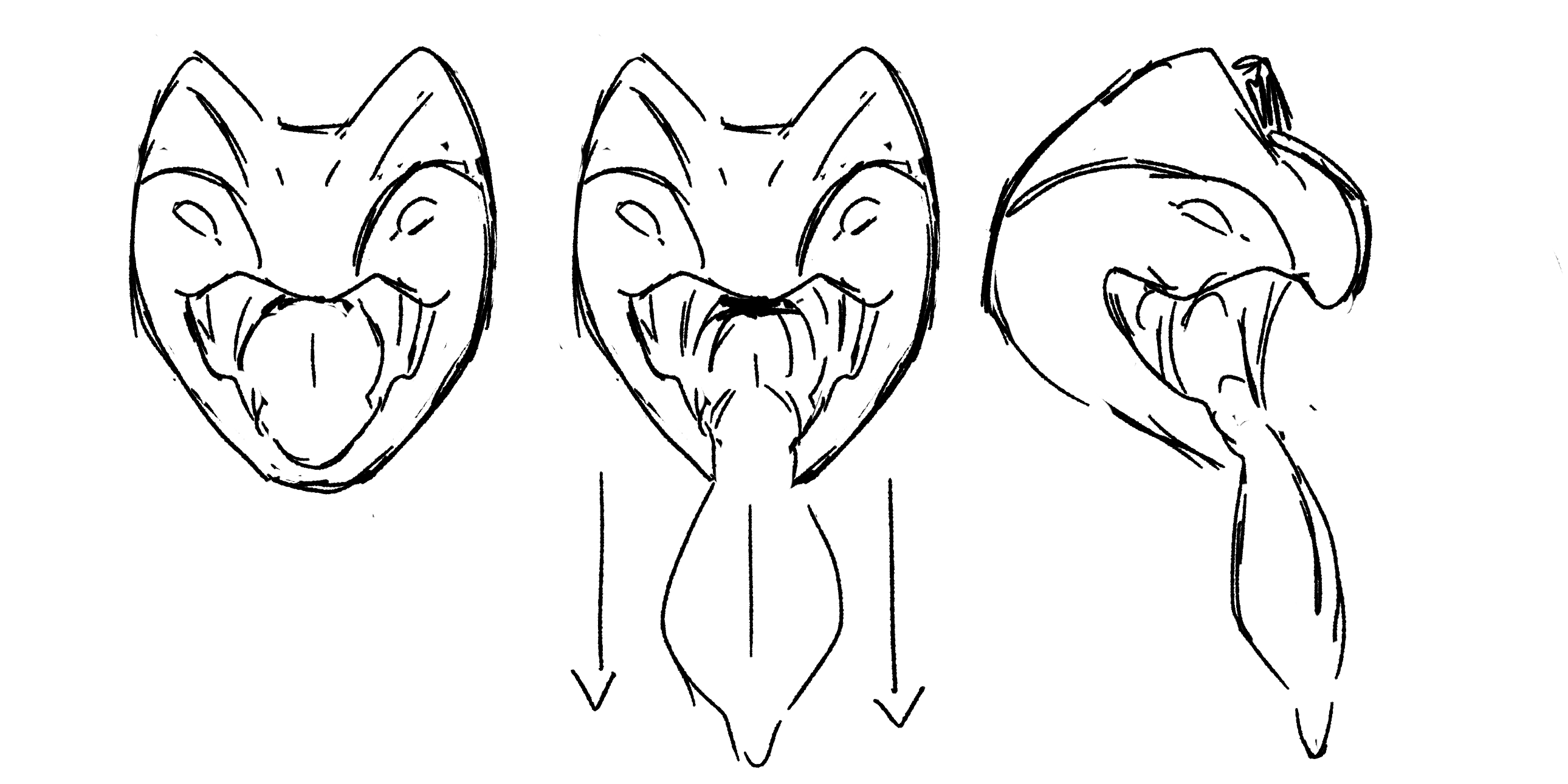
A diagram of the inside of a Hanasei's mouth, and the mechanism of their tongue.
Hanasei lack teeth, using their upper jaw protrusions to grasp and tear food instead. Their bite force is powerful, being able to clamp down with immense pressure. Their tongues function like a catapult, with the tip facing the inside of the mouth at rest and launched outwards when needed, further aided by their saliva being sticky enough to trap prey inside their mouths. With the advent of cooking and more efficient methods of getting food, this isn't a common practice anymore - unless one spots a quick snack. Unlike the other sophonts, Hanasei are still able to eat raw meat and may supplement their normal diet with bugs, fish and other easy to snag creatures in between activities.
They have very powerful and sensitive taste buds, coupled with a taste disc that lets them distinguish between minute differences in food. Their mouth, just like most of their organs, tends to take the most prominent color of their Aether.
Respiratory System & Speech
Hanasei has two different systems for breathing. Outside of water, their nostrils are open and air moves through their cavity into their respiratory organs, with their gills used for channeling sound. Air can be directed to their larynx, which is specialized for manipulating air into sound, similar to vocal cords; this is connected only to the gills and not the nostrils. This separation in systems means Hanasei can continually speak while simultaneously breathing, and their vocalizations are very impressive, being able to mimic almost any sound they hear with practice. They can alter these sounds by manipulating the openings of the larynx and/or gills. To keep their gills from drying out, the parts used for respiration often naturally retract or close, but Hanasei in drier climates must manually moisturize their gills at regular intervals to prevent internal damage.

A hanasei speaking through their gills.
Underwater, their nostrils close and their gills stay open. Most of their larynx closes, while filtration capillaries expand to better capture oxygen diffused in the water. This makes vocalization underwater impossible, with sign language being the most common replacement. Hanasei can have 2, 3 or 4 gills on each side of their neck, and the shape of the gill can vary, creating "accents" for each Hanasei in their relaxed voice.
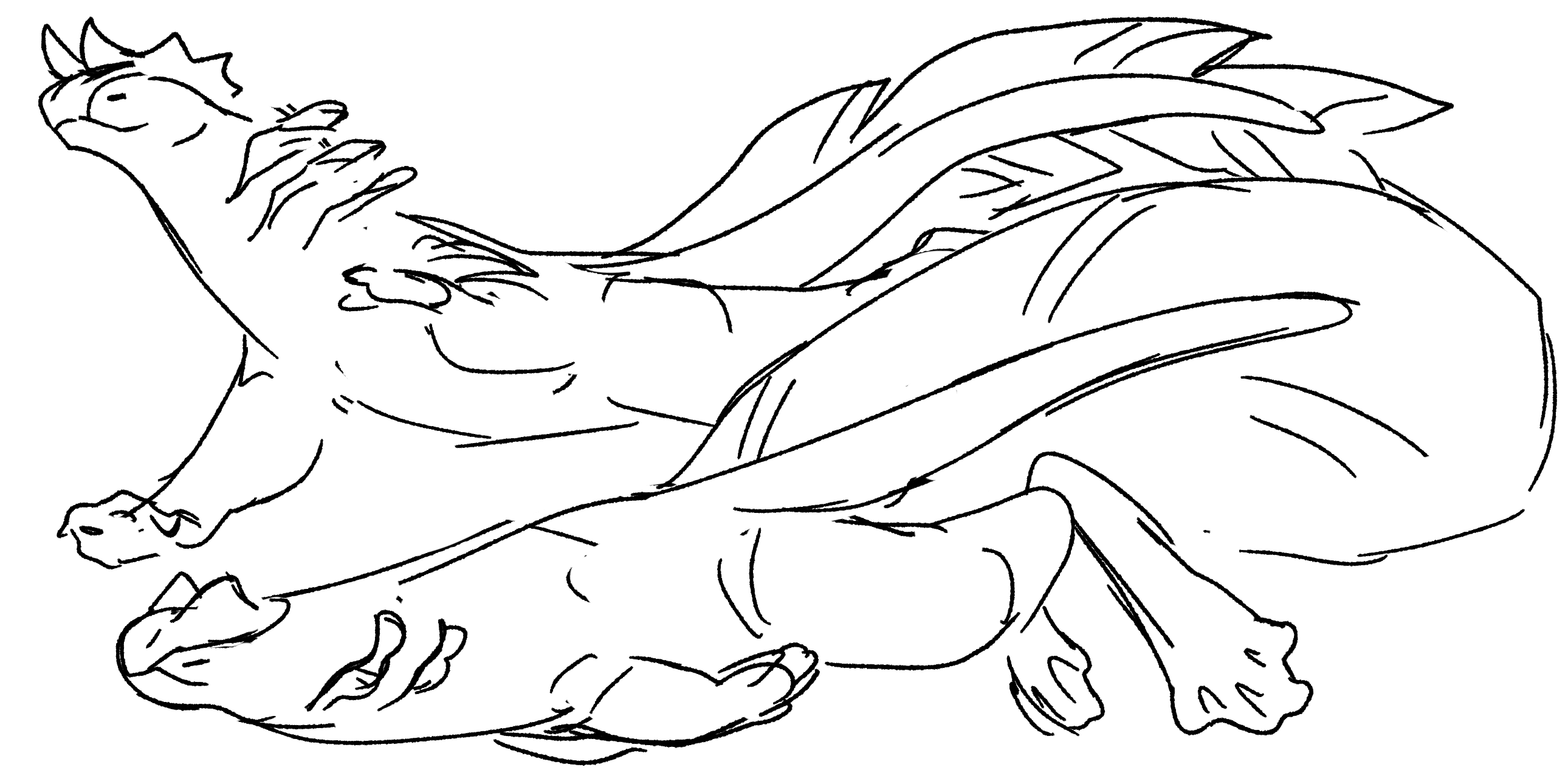
Two Hanasei swimming, showcasing their filtration capillaries in action.
They have a good olfactory system, this being one of their most reliable senses. They're able to smell the humidity in the air and incoming rains and droughts. But because their olfactory system requires the use of their nostrils, they're unable to smell anything underwater.
Body
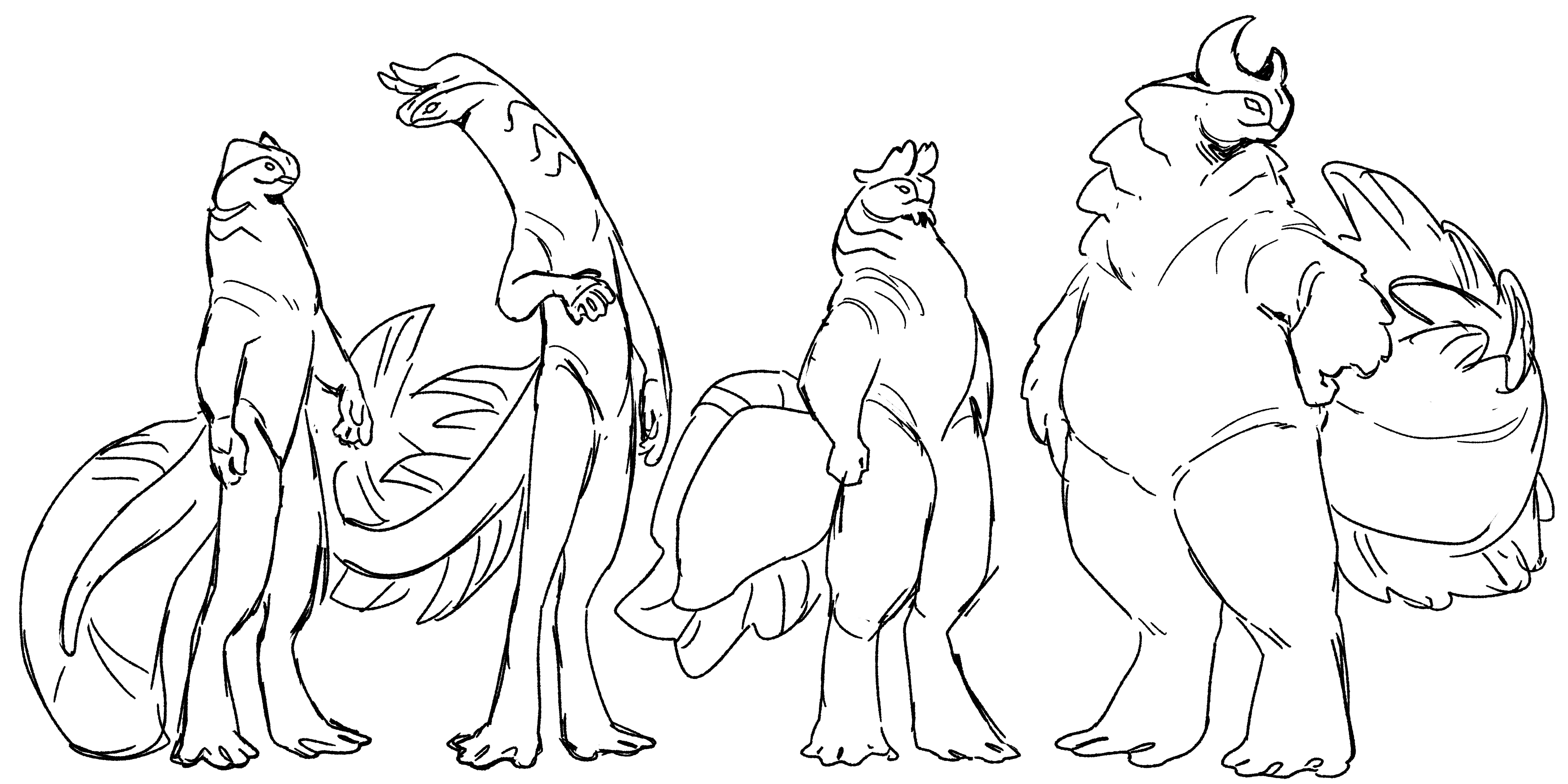
A small glimpse at the range of Hanasei body types.
Hanasei sizes and builds are diverse, with individuals’ varying accumulation of muscle mass, fat and other outside factors influencing how they look. Their proportions tend to stay consistent, with necks around the same size as their torso, short arms and elongated legs bigger than the torso itself, but deviations aren't uncommon.
Limbs

Hanasei hands with their membrane retracted and extended.
Hanasei arms start with their shoulders placed at the lower area of their torso and stop with hands reaching their hips. Despite the shorter length, they have impressive arm strength; even weaker Hanasei are known to rival other species' average. This makes them great at carrying things and grabbing and holding down prey and foes. Their hands are dexterous when the webbing is retracted, but they lose a lot of maneuverability when extended.
Their legs are long and muscular, granting them an upright walk. They're not very fast, averaging 7 km/h running speed, but they have great endurance and the ability to jump both high vertical distances and pounce forward if crouched. Their muscle system can lock into this crouched posture, a comfortable stance comparable to sitting. Their feet are digitigrade but the digits are big and wide with a large base, keeping their body balanced and stable at the cost of mobility and grace.
Tail
Hanasei tails are long, with a vertical caudal fin that often extends beyond the base which helps them swim. This fin can regenerate when damaged; as such, broken or rotten tissue will often lead to the entire chunk of damaged fin removed to speed up recovery and promote an even replacement.
Fins are classified into two types: regular and segmented. Regular fins are connected into one piece, while segmented fins are broken down into various fins of different sizes and shapes, similar to fish fins. No matter the type, their shapes are kept hydrodynamic and tailored for swimming. Sometimes the size of the base tail will also be shorter or longer than average.
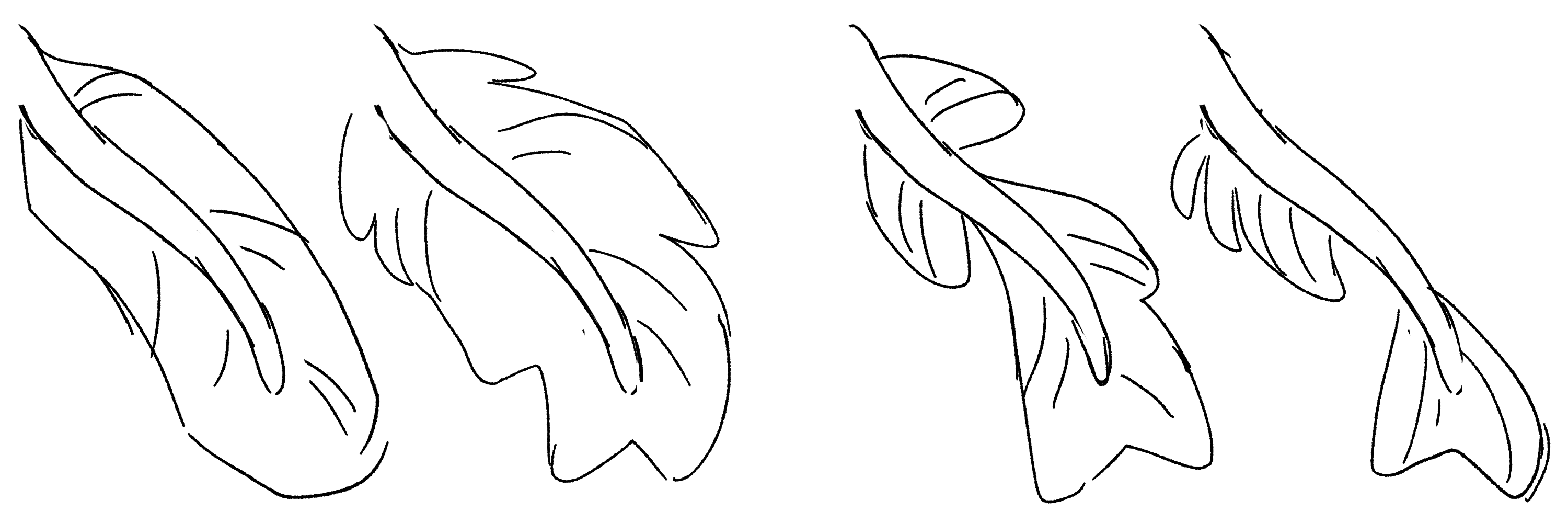
Left: Two examples of regular fins. Despite the different shapes, both are one single large caudal fin.
Right: Two examples of segmented fins. These fins can have different roots and number of segments, but will always have a fin at the tip of the tail, similar to fish.
Hanasei swim in two ways: a horizontal wave movement and by kicking their legs. The former is done with the help of their tail fins and is the slower of the two, but costs less energy. Hanasei will frequently alter the surrounding current with Aether to make this movement faster, with an average of 11 km/h. Leg kicks are less common in long term swimming, used instead for short bursts of speed and distance, though the longer one uses this method the more they'll tire and may be unable to swim without resting. The peak swimming speed of Hanasei is around 20 km/h, taking leg kicks into account. Because they originally evolved as ambush and endurance predators, this lack of speed was not an issue for them. Depending on their fin shape, individuals may develop other different ways of swimming.
Aether
Their natural Aether is Nam Aether. They make use of it to help their swimming, underwater hunting, and to keep themselves damp. They tend to cast Aether from their mouths, as their Aether glands are present on their throat.
In their breeding months, their Aether start producing cells for reproduction and lose their usual abilities. This months-long limitation leads to Hanasei refraining from using their Aether proactively or learning new skills, preferring to rely on technology to harness and utilize Aether instead.
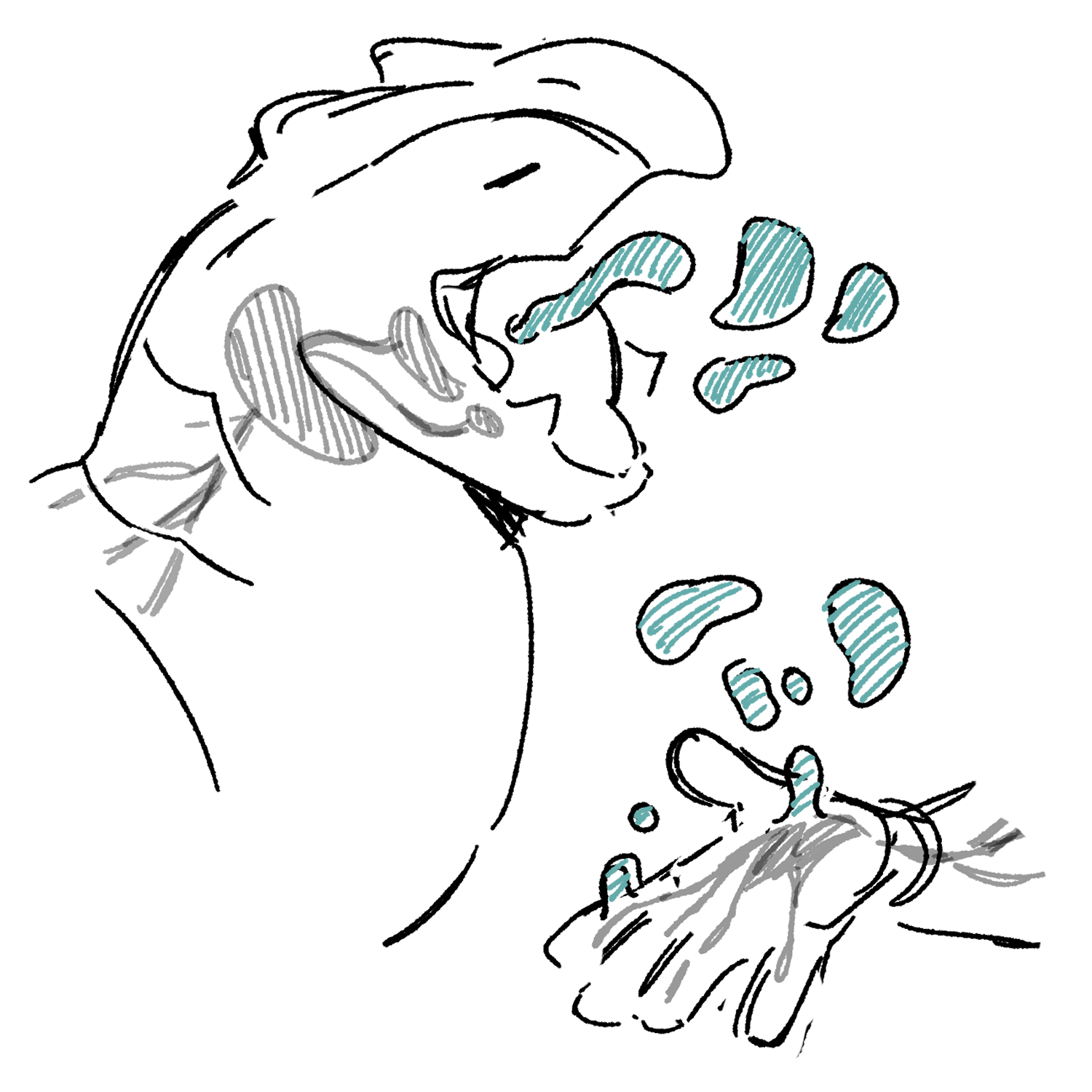
Aether casting from mouth and hand, with Aether glands and veins locations drawn in.
Reproduction

The development cycle of a Hanasei, to scale.
Egg
To create an egg, two or more Hanasei spit out and mix their Aether together in a body of water. The resulting foam will stick together and in 3 days will develop into an egg. One healthy Hanasei can produce enough reproductive Aether to make 200 eggs. This can only happen during the breeding season of Hanasei, usually in the 2nd and 8th months of the year. Modern Hanasei societies will instead send their reproductive Aether to established labs of the area that store it to create eggs using more efficient mixing machines and incubators.
The Aether inside the egg will segregate itself into larval stem cells and the nutritious yolk. After 12~14 days, the egg will be completely dry and the larva will emerge. The volatility of Aether means many larvae never form or develop incompletely; these “dud” eggs are discarded and repurposed or eaten. Only 1 in 50 eggs actually produce viable offspring, and this high rate of failure leads Hanasei to not view eggs as their young or a new generation, but more of a vessel that can fail or succeed. They have no qualms with re-purposing eggs in food, experiments or any other procedure.
Larvae
Larvae, often called notes, are very different from their adult counterparts. They're not considered sapient when they first hatch, but their growth is rapid and by 3 months in they'll have the intelligence of a one-year-old toddler and have leg and arm stubs growing, alongside the keratin helmet and an underdeveloped nostril. This growth is fueled by a great appetite; Hanasei larvae are omnivores and will eat almost anything they can fit in their mouths.
At the 9th month, they'll have most of their limbs developed to their young proportions, but their respiratory system will need an additional 3 months to allow for continual respiration outside water. Larvae at this stage will take short jaunts onto land to push their muscles and lungs until they no longer need to return to water to breathe.
Young
Once a larva can fully remain outside of water, they're called a young. "Young" encompasses the child and teenage years, lumped together as they no longer share any major physical differences from each other or to adults. The rest of their growth will be in size and intellect, slowing down from the quick pace of their larval years into a more normal 20 or so years to reach maturity. The main exception are horns, which only start growing around their 5th year and can take over a decade to finish growing. Smaller horns may plateau faster.
Arts
Visual arts
Sculpture
Hanasei sculpture began with riverbed clay, which was easy to harvest and clean for artistic use and thus was one of the earliest art forms. Flow has always been some of the most important details for sculptors, and many focused on scenes that implied animation and movement. Texture was also relevant, as many pieces were made to be touched and moved around. Color is not a priority, with as many flat pieces as colored ones being made. The range of color used is limited due to Hanasei's eyesight, with blue and yellow being the most common.
Trends in how subjects were depicted variate depending on region and era. Some of the first works were heavily observational and referenced, while the proceeding era focused more on stylization and evoking subjective feelings. This cycle repeats every era, with variations on the type of reference and style to match the period's other trends. This makes it extremely easy to date Hanasei sculpture work.
Drawing and painting
Painting has been deeply connected to calligraphy. As Hanasei vision has more limitations than the average species, written works needed to be large and easy to distinguish, and tactile writing was common place. A branch of writers would experiment with ink, creating detailed versions of the characters that could be read at a distance. These works were reserved for small stories, which then branched into shorter original poems composed of very few characters, focused on visibility and beauty.
As experiments continued, artists began exploring not just writing, but the creation of abstract and contrasting shapes and flow on a canvas, originating the first painting genre of "linearnism". While sculptors remained grounded to the visual world, painters would focus on how to adapt emotions, sounds and stories into strokes. The main ink used was watercolor-like, with gave needed depth of figures by layering.
As painting became more popular and started interacting with other arts, different schools of thought such as concretism (the depiction of the surrounding world as is), folklorism (the mixing of real elements and fantastical abstractions) and others gained space. This alongside the acquisition of new material and foreign art movement branched the drawing world of Hanasei at mach speed.
Literature
Until recent times, most of Hanasei literature has been orature. Writing was tactile, and took a while to be condensed enough to transcribe stories. As such most written works were short stories or even shorter poems, and longer tales and knowledge were all spoken. Narration was extremely important, and the need for clarity on fictional, real and meanings of literary work are theorized to have given origin to SES (supplementary explanatory speech) in Hanasei languages. Early on, sound recorders were developed and allowed literature to spread further. They improved fast, allowing for hour and even days long narratives to be listened to anytime.
Literary works of Hanasei began with focus on how the world works and explorations of the unknown. Political works were also very popular, and still persist as one of the most popular themes of fiction and non-fiction. As more of Koegama became known, Hanasei moved from exploration of the world into exploration of the self. Transcorporealism *(transhumanism without the human part lol)* took front in narratives as ink morphs were first discovered and gained popularity.
While each genre has its own style, many Hanasei works are long and explanatory. World building and character building are important skills for any writer, and a work's engine making sense matters more than subtlety. Despite that, many works will still bring questions and ask readers to analyse the written explanations, and it's common for forums to discuss if they agree or disagree.
Architecture
As most Hanasei live in riverbeds, lakes and mangroves, their architecture surrounds water and water resistant materials. Houses, crosswalks and ports are raised on stilts, avoiding the flood seasons and letting air circulate along the cities. The design of buildings is brutalist yet light, with plants, moss and gardens being a very popular decoration to walls.
Some buildings are settled partially or completely underwater. In most cases, they have out of water entrances and storage for any items that cannot be submerged. Underwater architecture forego the brutalist trend and will be designed to not affect the course of water and maximize the space used, making them packed and somewhat hard to navigate.
Crosswalks are only built for walking and light transport such as wheelchairs and individual motorized drivers, and they have tactile symbols engraved, updating the user the directions of all surrounding buildings and any noteworthy locations. Larger transit is done by boat and canoe.
Clothing
Being in and out of water led to nudism being the default for Hanasei settlements. This leaves all clothing to have a statement, whether casual, formal or rebellious. In case of mixed-species settlements, clothing is more popular.
The most popular styles are skin tight, which avoids the issue of underwater drag. Fancier or more fashion forward individuals will buy containers, which store items and shrink with Aether and are easy to carry around. This allows them to take off clothes if they need to swim, but most will just tolerate the drag or buy lightweight textiles.
Tops are more popular than bottoms, worn by tying down the sides, front or back. Layering is also common, especially to showcase different textiles or textures.
Because of their skin being slightly absorbent, Hanasei can taste any clothing and apparel they wear. This has lead to the creation of detergents, incenses and undergarments to help those who do not enjoy the taste of certain fabrics or dyes. Some prefer to avoid the disliked materials all together, though not always possible due to some of it being required work or security apparel.
When clothing isn't desired, accessories and tattooing is the main form of decoration. Piercings, horn jewelry and neck collars are made to fit the individual or a group, and come in various shapes and meanings. Common tattoos are large, featuring various fauna, flora and shapes the client enjoys. Clashing and contrasting colors are popular to make them stand out from the rest of the body.
Music
Music is as much of a auditory experience as a physical one to most Hanasei-originated genres. Some instruments will not create any audible sound, rather being sensed as vibrations to the rhythm of the song. This creates a 3D experience to listeners, and other species will claim it to be "loud and bassy", even if softer songs.
While not completely absent, most Hanasei music will not contain any lyrics. Rather, the instruments and vocal sounds will describe meaning to a song. As a song progresses, changes in chord, new instruments being added and the removal of others signal the change in imagery, meaning and "plot". Songs made with no concern for the symbology of its sounds has its own macro-genre called "Nonsense".
Lyrical songs used to be reserved for prayer and chants, but as religion became less common, lyrics are associated with festivals, narratives (such as historical songs or theater) and foreigner genres.
Instruments
From small portable tambourines to larger drum sets and marimbas, percussion has been the main type of instrument used in Hanasei music. The most common instrumental roundup for a traditional song will consist of various percussionists and vocal backers to sing out any needed sounds.
The only string instrument of Hanasei origin is a Zanau, a long decorated arch with two strings and a resonator. Despite its appearance, it is played like most percussion: the strings are hit with sticks to create sound, with the height of the area hit and if one or two strings were hit changing the sound's characteristics.
Luminae and Tajira string instruments were brought in, but their needed adaptations for Hanasei's hands created different sounds from the original. While these adapted and modified instruments found place in Hanasei modern music, "authentic" instrumentals for other species' songs and tools often come by vocal.
Due to their anatomy, Hanasei are unable to use wind instruments, being the exclusive domain of vocalists.
Cuisine
Hanasei are obligatory carnivores, and their cuisine focuses on numerous meat sources and their unique cuts and preparations. Algae and plant matter are used sparingly as spices and decoration.
Seafood
Almost 70% of protein eaten by Hanasei is seafood. Most sources are domestic species farmed in underwater breeding grounds, though fishing and hunting are still common for wild fauna.
Raw seafood is popular. Enaerin is a large plate with raw fish submerged in a sweet sauce named enanum, which breaks down the meat and gives it a juicier taste. Other common preparations are boiling fish with different oils - all of which stain the meat with different flavors - and smoking.
Shelled animals are boiled and eaten whole, sometimes with extra fillings inserted on the shell after cleaning. They're a common dessert and snack, popular with kids.
Landori
Landori is a term for meats that come from waterfowl and flightless birds. For domesticated landori, the meat flavor is strongest when well-done. Acidic sauces will be used to soften the dish if needed, but the majority eat it hardened, as Hanasei jaw strength makes it a trivial task and the texture is considered fun to chew on.
Don-don strips are a common side dish to main courses. The meat is cut in cubes and cooked well done, complimented with sea-grass and algae. The cubes are meant to be placed inside a dish to add texture, but some eat it by itself.
Endori
Endori is a term for arthropod meats and snacks. Small arthropods are stored live, dried or coated in algae crumbs and fried, with the latter being a more modern dish as fried food gained popularity and space. They're snacks, eaten between meals and considered too small to be used in larger dishes. One of the most popular types is Oh're Crrk - "crrk" being the word for something that's crunchy and would make a similar sound.
Larger arthropods are treated as a mix of seafood and small arthropods. Often eaten raw or boiled, the exoskeleton is part of the dish and made even crunchier. Endori is saltier on average, and will be eaten with brews on the side.
Language
The language family in Hanasei areas is Uushu, which contains around 4 languages: Ii'mau, Anguân, and West and South Yomi - the latter of which are still debated if they're similar languages or very distinct dialects of a single Yomi language.
Due to their vocal capabilities, all of the Uushu languages share the distinction of having an excessive amount of phonemes, from 120 to over 300. They are classified under semantic and non-semantic.
Semantic phonemes have meaning imbued in them. They're often similar to onomatopoeia, imitating the sounds of things and movement.
Non-semantic phonemes are sounds with no meaning, often used for grammatical functions and abstract concepts which make no sound to mimic.
The main variance between Uushu languages are the non-semantic phonemes and grammar rules. Semantic phonemes have been largely preserved from the original proto-Uushu, with a few changes and exceptions unique to each language.
Writing script
All Hanasei languages use tactile writing, and the style of characters is very similar: Points and waves are used to write down each symbol, and the elevation of each part gives extra meaning, or can even change it altogether. Modern writing is very compressed, and one symbol can be one or even more words at once.
Names
First name: Hanasei are given given temporary names by nurses and caretakers, and can swap their names multiple times through their lives. Usually one word, which can be a single concept - such as "Finch" or "Star" in English - or a fusion of multiple words into one. Some even pick verbs, adjectives etc, but nouns are the norm.
Examples: Ché (Waterfall), Brotûk (Tumbling rocks).
Second name: Their profession, skill, or specialty. These terms are broad, and can include various professions in one.
Examples: I'paàma, which means "leaf skill" and groups anything related to botany, farming/agriculture, etc
Third name: Their age, which only applies for adults and up. There is a name for the 22-50, 50-80 and 80-100 ranges, and then one for 100 years old and up.
Fourth name: Their residence. Most Hanasei don't change it even after they move from their birth place, so it often means their birthplace just as much as it does their current residence.
A full Hanasei name would be structured like so: CHÉ-I'PAÀMA-GALAM-WAHATISE BO. The more of the name is said, the more formal it is.
In normal conversation, first and second name are expected for strangers and only the first name is said for those closer to you. If the Hanasei being spoken to is older than the speaker, the third name is also applied. Older Hanasei who are close to the speaker may be mentioned with a first-third structure, bypassing the second name.
Society
- Conformation and creativity. Hanasei like to do things together, and purposefully standing out is seen as weird and lonerish. Because of the overlap of generations and age groups, Hanasei will often have a lot of different trends going on, so there's still leeway with personal choice. If you want to introduce a new trend, its common to start at not just by one person, but by a friend group.
- Imitation and adaptation. Because Hanasei like to do things together, their philosophy could be summarized in "imitation is flattery". They love creating styles, design and food from other Hanasei communities and other species. Having something catch on and be copied is a great honor and the goal of many Hanasei. This can clash when they start learning and reproducing other species things and forgoing their cultural context or how sacred they are.
Age
- Teens are to be taught about the world, basic knowledge, common sense etc. they are not expected to work and to contribute in the community, and don't have voting rights but usually have political protections.
- Young adults are expected to contribute, usually with tasks such as organization, cleaning, etc. They don't have to but its the common age to specialize into something. Jobs will often turn down young adults from specialized careers, unless they were an apprentice or closer to transitioning into an older adult. They don't have to stick to one specialization, and its common for them to experiment, swap and do multiple things. they start having voting power and most are expected to be politically active and participate in policy making.
- The main change from older adults is that they can now enter specialized jobs as long as they have the requirements. Some prefer to contribute in community work. Older adults are allowed to start political debates and new law additions for the community to vote.
- Elders are free to retire, and no longer need to participate in politics if they don't want to. They still have all political rights as older adults, and their takes are highly respected and tend to have priority in debates.
Customs and Celebrations
- Celebrations happen when the flood and dry seasons arrives. Used to be religious but nowadays they are secular. Flood celebrates the arrival of marine life to breed and continue the cycle which gives them food. Many feasts, art festivals and watching the upcoming species rush to their breeding locations. Dry season is about mourning and cycles. Saying goodbye to beloved ones, preparing for the next flood.
- Hanasei graduations from foundational schooling are a mark of adulthood and come with wild celebrations. Graduates are dragged to tour the city and appreciate as many areas as possible (tours may change catering depending on the individuals preferences), all coming down to their home for a final party.
Pop Culture
To be written.
Politics
In Hanasei circles, every 3 months a political congregation is made which calls for all young adults and up. in these congregations, they'll go through each section of their society, and groups will propose their policies for each section. policies are almost always created by older adults and elders, though younger adults with an older generation patron can also propose policies.
Debate is encourage for each proposal, and its thru debate most young adults tend to get patronage for policy making and its the best way to become a predominant political voice. These policy creations and debates can last days depending on how long theyre debated and how many want to throw their hat on the ring. policy talk usually favor age, and then political renome as for order. once political debates are over, hanasei must vote on all policy proposals. those who couldnt go could watch the debated live or watch a recording afterwards. votes are done by an "online" tracking system, so most do it at home.
After the voting is over, the approved policies will be implemented. despite some cities being really big, this system is still upheld, but policies are done by forum debates instead. some traditionalists think this is eroding the traditional art of political debate, but others say its increasing the number of political active participants and also making policy debate faster even with a larger number of participants.
Laws & Codes
To be written.
Religion & Beliefs
- Most Hanasei are secular. They view religion as outdated and historical. This causes clashes with more religious species, such as Luminae.
- Religious Hanasei are 97% Ichorrists, with 3% being assorted small religions.
Ichorrism
- Hanasei who view Aether as the blood of a god, which poured in Koegama and brought life to the planet.
- They view Aether as sacred and Aether abilities as harnessing the power of the old god itself.
Maréism
Considered a dead religion, many of its practices and texts have been lost to time, but a conservation effort by Ichorrists, anthropologists, and archaeologists seek to preserve the information possessed and search the lost links of Mareímism.
Maréimism was a religion that focused on the worshiping of Maré, a large river spirit, believed to have flooded the Koegama world, barren beforehand. The waters they created gave way to life, and Maré blessed any who lived in their domain. Objects found suggested that believers would create small rafts with flowers and crafted sculptures and send them downstream into the sea, as a gift to Maré.
According to surviving texts, Ikissame was the first Hanasei, and they decided to ask Maré to explore beyond the water and salvage the unchanging and hostile land, where nothing lived. Maré doubted them but allowed them to try. After many unsuccessful attempts to bring life to the ground, Ikissame decided to give up their Aether to bless the land they stood on, and their sacrifice brought the land new life again.
Maré saw their sacrifice, and, impressed, decided to bless them. They recovered Ikissame’s Aether, and gave it the gift of life, allowing them to create more Hanasei and make the land their home. They also promised that, while they couldn’t give back their Aether, Ikissame would have an opportunity to learn every ability one day. Some texts show a glimpse of extra tales of Ikissamee and their descendants, but too little has been retrieved to understand the narratives.
Folklore
To be written.